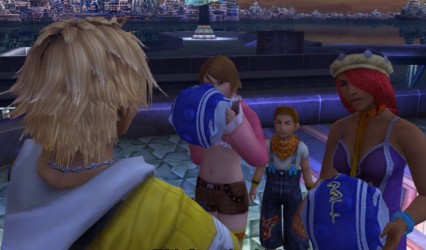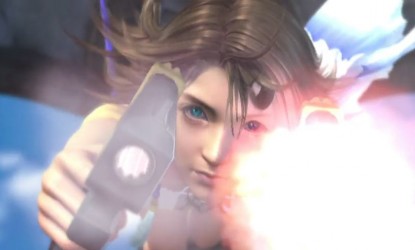Reviews
Final Fantasy X / X-2 HD Remaster
May 3, 2014, Author: Andy Corrigan
Final Fantasy is one of those franchises that manages to divide its own fan base with every new release. As popular as series poster child VII is, for example, there are many people (crazy, in my opinion) that actually see it as a weak point and hold other iterations, both older and newer, in higher regard. Final Fantasy X is one of those many proclaim to be the very best Square Enix has ever produced, yet much like in the scenario above I personally was never much fond of it.
Being curious as a series fan, however, and with Square Enix deciding to dust off the adventures of Tidus and chums – plus the less popular direct sequel – for a HD re-release, I was more than happy to revisit Spira. In this instance, I found Final Fantasy X in particular to be a classy, character-driven adventure that was far more worthwhile than I originally gave it credit for, while its hyperactive follow-up entertained despite being… well… bat-shit crazy.
Final Fantasy X introduces you to its plucky young protagonist, star Blitzball player Tidus, as his home town of Zanarkand comes under an attack from a hulking monstrosity known as Sin. As Zanarkand succumbs to Sin’s destructive power, Tidus finds himself flung 1,000 years into the future, where he meets the instantly likeable summoner, Yuna. Hopeful that her upcoming pilgrimage across the world of Spira might hold the key to his passage home, he joins her group as a guardian.
In my first stab at FFX, I remember hating Tidus as a protagonist. His relentless optimism was aggravating, and worse, he was two-dimensional when compared to other genre heroes. Unfortunately, despite being a little more receptive to his merits, my opinion on him hasn’t changed much, though rather than giving me a constant cause to dislike the story this time, I came to something of a realisation. FFX isn’t really Tidus’s story at all; it’s Yuna’s. Her character development is by far and away the most significant; she’s the one with the most to lose, she’s the one with all the power, and the party members are risking their lives because they believe in her. Once I had this moment of clarity, FFX’s story arc was suddenly a lot more compelling.
Also, with the benefit of hindsight, it’s clear that FFX makes commentary on some real-world issues. In dialogue, for example, it becomes obvious that the cultural difference causing friction between party members Wakka and Rikku boils down to opposing views on religion and Atheism, while the beastly Kimahri’s motivation lies in finding his place within his own species. There are plenty of thematic offshoots like this and, despite FFX never being quite brave enough to nail its colours to the post in any of these scenarios, it’s the sort of subtle layering that’s been missing from more recent efforts.

The calm before the storm…
The combat is in the traditional turn-based format but has many brilliant little systems that help to set it apart. For starters, party members can be swapped in or out at will during fights, a nifty little feature allowing you to deal with any enemy type. Attacks or actions unique to major fights are also common, be it requesting that your airship be pulled closer to a gigantic foe, or talking to the target to get a psychological edge. Even seemingly aesthetic design choices can be incredibly useful, such as the turn order being displayed down the right-hand side of the screen allowing you to plan your attacks in advance; an ability invaluable against bosses.
As with previous Final Fantasies, every time you attack or take a hit you’ll build up a gauge next to your character’s name and once full you can unleash a powerful Overdrive attack, similar in execution to FFVII’s Limit Breaks. Summons, called Aeons in this iteration, are handled a little differently but brilliantly so. Only summonable by Yuna once per battle, Aeons will replace your entire party until you beat the enemy or they get knocked out. They too have their own Overdrive moves, way more powerful than anything your regular party can dish out, of course.
FFX surprised many by ditching the traditional ‘levelling-up’ system. As you win battles, you earn ‘AP’. Once you get enough AP, you’ll gain a S.LV (Sphere level) which lets you take one move on the Sphere Grid – a huge board packed with incremental stat increases and abilities. These stat boosts and powers then need to be bought with the appropriate sphere (physical, magic, ability), all of which are earned in battle. All party members technically use the same Sphere Grid, and that means eventually your party could all learn the same techniques, but each starts in a different area of the board, forcing your early focus and keeping your team nicely balanced. I got really addicted to grinding because of this set-up, and with multiple branching paths it was kinda neat to shape my characters the way I saw fit.
One thing that really struck me about Final Fantasy X was its structure. Rather than opening up to an overworld early on and letting you plot your own course and explore at your own pace, you follow Yuna’s pilgrimage from start to finish on the exact route she takes. This means that each area is connected in a natural path with few meaningful deviations, and thus when compared to previous entries, FFX can feel incredibly linear. Sound familiar? It should. I’ve seen countless fans belittle Final Fantasy XIII for its linearity but in the same breath call FFX one of their favourites. This has proved baffling as structurally both games are almost identical, even opening up at similar junctions and in comparable ways. As someone who liked FFXIII, this absolutely wasn’t an issue for me here, and it’s hard to complain when Spira is so varied and visually pleasing.
It also helps that there’s plenty to do on the way; side bosses, hidden dungeons and monster arenas are all worthy pursuits for those that like to obtain bragging rights. Blitzball, though, is FFX’s main diversion. Playable from any save point, you can lead the Besaid Aurochs through league competitions and knockout tournaments, even sign new playing talent from the citizens of Spira. It’s surprisingly deep, and I spent much more time in here than I did in 2001.
Final Fantasy X-2 is set just a few months following the events of the first game and Yuna, now the main character, has quit her role as high summoner and joined a group of Sphere Hunters. While FFX was came across as a thoughtful and touching adventure, X-2 feels a little schizophrenic, positioning itself as a Charlie’s Angels parody thanks to the light-hearted relationship between the three main protagonists, Yuna, Rikku and newcomer Paine. X-2’s focus swings wildly throughout thanks to bizarre pacing, which results in such oddities as the trio striving to put on a concert in the penultimate chapter, just when you’d think the impending threat would be a more pressing concern.

Yuna’s change in X-2 comes as quite a surprise…
The story isn’t the only thing far removed from the prior game. The battle system is unexpectedly similar to Final Fantasy VII’s Active Time Battle system, only a lot faster and satisfyingly paced, while levelling up your general attributes reverts to the classic XP system.
Rather than each character commencing as a specialist class, however, their abilities and weapons are determined by ‘Dresspheres’; namely the clothes in which you choose to dress them in. The ‘Songstress’ dressphere, for example, is a support class, allowing your character’s funky dance moves to cast blind and other status ailments on enemies, while attack-based classes like Gunner or Warrior are used to dish major damage. There are a ton of dresspheres to find as you progress, all specialising in different magical or physical abilities, and there’s a lot of fun to be had in tailoring the characters to fit your own strategies and battle plans.
Your characters are never permanently bound to these classes, though. Thanks to Garment Grids, you can change your character’s role in battle on the fly, opening up a ton of interesting tactical options, while the various types of garment grid can also provide their own benefits for regular costume changers. Any character can use any role, though progress in each – including the abilities they unlock – is tracked individually, so the more a character uses a role, the more abilities they’ll unlock for it.
With the Aeons no longer in action, there are no summons to speak of in X-2, however you can capture fiends in a hands-off, menu-only process on the team’s airship, The Celsius. Once caught, you can train them up and then use them in battle in place of your main party members. This is a cool feature, sure, but the process is entirely optional; your core trio are more than enough to finish the game alone and, for me, this didn’t prove a worthwhile enough distraction.
Structurally speaking, X-2 is a lot more open than its predecessor. With the Celsius acting as a hub of sorts, you can visit any location across Spira from the off, with story missions indicated by ‘Hot Spots’. All locations feature worthwhile side-missions over the five chapters, however; and these yield some of the best gear, dresspheres and garment grids. The areas nearly all appear exactly as they did in FFX, but it is exciting to explore them in these new and interesting ways, and see how the world has changed in the wake of the original team’s battle with Sin.
There are some trivial bonus features that come in the package, but their value to you will depend on how much of a fan you really are. FFX features ‘Eternal Calm’, a lengthy in-engine cut-scene that bridges the gap between both games, while X-2 has ‘Last Mission’, which is more of a playable mini-game that tracks the sequel trio’s reunion after a few months apart. Personally, I found neither to be particularly worth my time, but others might enjoy the additional insight.
Being last-gen games originally, of course there are some design factors that simply don’t hold up by today’s standards, such as low-quality NPC faces and character models, plus some stiff animations. Thankfully, the colourful design philosophy goes a long way in masking their age and regardless of whether you opt for the PS3 or Vita versions of this HD collection, you’ll find a solid performance without any technical issues. The only advantage the PS3 edition has over its portable counterpart is that the audio has had some minor and understandable compression in the handheld version, which impacts slightly on the overall quality but not enough to really gripe about.
Square Enix did unfortunately stop short of making the HD Remaster a cross-buy purchase, but if you do happen to buy it for both platforms then the inclusion of cross-save makes for a worthy mention. I made good use of this feature while reviewing and it’s flawlessly implemented and very easy to sync your progress across both platforms. Handy!
Not in the slightest bit Tidus
Final Fantasy X / X-2 HD Remaster does exactly what it says on the box, providing a high-def gloss to two beloved RPGs. It’s inevitable that both games will show their age here and there, but their absorbing systems hold up decently over a decade after their original releases.
While Final Fantasy X is the one that people will and should pay the entry fee for, X-2 should not be ignored. In spite of its weird direction and lop-sided pacing, a solid RPG lurks beneath its quirky exterior.
Platforms: PS Vita, PS3 | Tagged Auron, Final Fantasy, Final Fantasy X, Final Fantasy X-2, Laughing, Levelling, Paine, Rikku, Sin, Spira, Tidus, wakka



